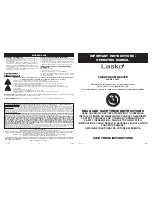
32
BULLETIN 22
SMELLY WATER
CAUSES
The most common cause of “smelly water” is a non-toxic sulfate reducing bacteria,
scienti
fi
cally termed Divibrio Sulfurcans. This bacteria often enters the water system
through construction or a break in ground piping. The bacteria creates the energy it
needs to survive by converting sulfate (SO4) to hydrogen sul
fi
de(H2S) gas you smell in
the water.
Hydrogen sul
fi
de gas is distinctive because of its rotten egg-like stench. Its presence
can severely affect the taste as well as the odor of the water. Occasionally this bacteria
can be accompanied by black deposits, the result of pipe and
fi
tting corrosion. In
extremely high concentrations, hydrogen sul
fi
de gas can be toxic though the gas is
detectable long before harmful levels are reached.
The requirements for the bacteria to thrive are: a) an elevated level of sulfur in the
water, b) activated hydrogen from cathodic reactions within the tank, c) water with little
or no dissolved oxygen, d) and temperatures below 138°F.
Items that can increase the potential for this bacteria are: a) water softeners, b) well
water, c) and long periods of no water movement.
Other factors that may contribute to smelly water:
•
Chlorides of Magnesium and Calcium leave a bitter taste.
•
Chloride of Sodium produces a salty taste.
•
Sulfates (50 ppm) gives a medicinal taste.
•
Carbon Dioxide in a low pH water gives
fi
zzy water.
•
Iron and tannic waters also give a bad taste and odor.
TREATMENT
The simplest treatment available is the shock-chlorination of the system. This
is a surface treatment, and often requires repeated trials in heavily infected
systems. The chlorination of a system requires that you follow each step
explicitly to avoid an un-treated portion of the piping system from reinfecting
another part. See Bulletin 23 for the chlorination procedure. Longer lasting
solutions include chlorination or aeration of the water supply.
NOTES
Since rusty water is caused by a bacteria presence and is not caused by the
water heater, any treatment would not be considered warranty related.













































